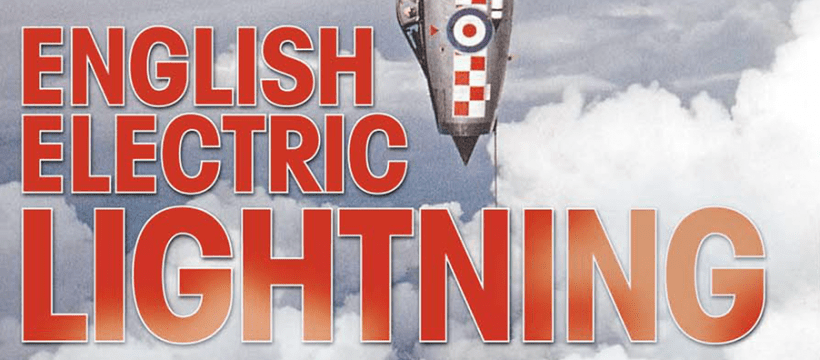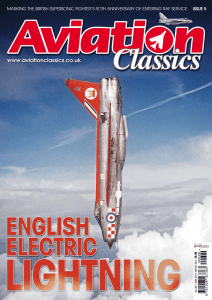 It was a balmy autumnal morning at RAF Swinderby in Lincolnshire on 17 October 1984. That was the date of my passing out parade from basic recruit training in the Royal Air Force, and while we were promised the customary flypast, you weren’t told what aircraft it would be carried out by. I was hoping for something ‘tasty’.
It was a balmy autumnal morning at RAF Swinderby in Lincolnshire on 17 October 1984. That was the date of my passing out parade from basic recruit training in the Royal Air Force, and while we were promised the customary flypast, you weren’t told what aircraft it would be carried out by. I was hoping for something ‘tasty’.
After the reviewing officer had arrived and taken up his position on the dais, we were ordered to present arms for the General Salute. As I positioned my rifle and its shiny bayonet right in front of me, I heard a great roar and caught sight of two Lightnings flashing overhead – what a welcome into the RAF!
And so it would seem to be that, while I never served on a Lightning unit, all the times that I came into contact with the superb jet fighter would be memorable.
My next encounter was after a long shift, when a search and rescue operation at RAF St Mawgan in Cornwall had kept us busy until late as a 42 Squadron Nimrod had been extensively involved. As I left the operations building the sun was just setting and there was a summery golden glow in the sky. I had noticed the arrival of a Lightning at the base earlier that day, and its departure fortuitously coincided with my leaving work. The sight of its two afterburners glowing as they powered the jet up into that golden sky is still vivid in my memory.
Then, in early 1988 while I was part of the RAF Germany Harrier Force at Gütersloh, we were paid a visit by four Lightning F6s from 11 Squadron which were to carry out Dissimilar Air Combat Training with our Harrier GR3s. This was quite an occasion, as it was the last time the jets would visit this former Lightning base, and their imminent departure had been much talked about. Two-by-two the F6s lit the pipes, set off down the runway, then went vertical for a trademark Lightning ‘rote’. Even to those who worked with fast jets on a daily basis and were consequently almost blasé about being in such an environment, this was a breathtaking sight. But with it there was a feeling of sadness, as yet another era of RAF operations was coming to a close.
Little could I know at the time that over 20 years later one of the pilots on that detachment would be writing for me! In fact, I am fortunate to have been offered the writings of several former Lightning pilots for this issue of Aviation Classics, which has added to the variety of content tremendously. For example, Sqn Ldr Clive Rowley highlights the little-known operations of the F2As in West Germany, Wg Cdr John Ward gives a fascinating insight into the Lightning’s weapons system, while Ian Black charts the type’s last year in RAF service. There is also a rare treat from Gp Capt David Seward, who tells of the 1963 ‘Firebirds’ aerobatic team. For those of us who enjoy watching the Red Arrows, just imagine a diamond-nine of Lightnings carrying out a loop!
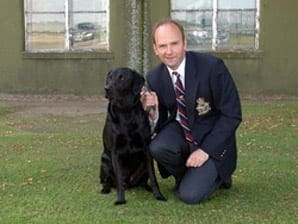 What I hope is that the result marks the type’s 50th anniversary of entering RAF squadron service in a fitting manner. At the time of going to press this occasion was soon to be commemorated by a special open day at the Lightning Preservation Group’s Bruntingthorpe home, which was to also formally open the recently-completed Q-shed. This now houses the organisation’s two F6s as a fitting tribute to those who stood at constant readiness to defend our country during one of the most tense periods of history.
What I hope is that the result marks the type’s 50th anniversary of entering RAF squadron service in a fitting manner. At the time of going to press this occasion was soon to be commemorated by a special open day at the Lightning Preservation Group’s Bruntingthorpe home, which was to also formally open the recently-completed Q-shed. This now houses the organisation’s two F6s as a fitting tribute to those who stood at constant readiness to defend our country during one of the most tense periods of history.
Jarrod Cotter
Editor
 Contents
Contents
6 Introduction – Going supersonic
8 Dawn of the Lightning
18 ‘Tigers’
22 A Pilot’s perspective
30 Thoroughbred Fighter Station
34 Lightning weapons system
40 Lightning F3 cockpit
42 The ‘Hole on the Wall’
48 ‘Bee’ – test pilot of the ultimate British fighter
50 Lightning F6 in detail
52 ‘Gas guzzlers’
54 Binbrook – the Lightning years
62 Lightnings live on!
74 Thunder City
78 A Lightning life
86 “Mayday, Mayday”
90 Scramble!
92 ‘Brass Monkeys, Battle Flight and Low-Level’
100 ‘Firebirds’
104 Fighting the Lightning
108 Eject! Eject!
110 Air defence generations
112 Lightning sunset
118 Riding the Magic Carpet
122 Last of the Lightnings
The ‘Hole in the Wall’
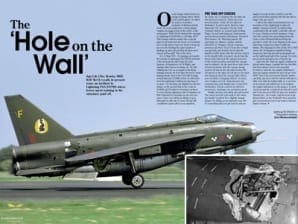 A special preview feature from Aviation Classics – English Electric Lightning – Sqn Ldr Clive Rowley MBE RAF Ret’d recalls in present tense an incident in Lightning F2A XN789 where hours spent training in the simulator paid off.
A special preview feature from Aviation Classics – English Electric Lightning – Sqn Ldr Clive Rowley MBE RAF Ret’d recalls in present tense an incident in Lightning F2A XN789 where hours spent training in the simulator paid off.
On my lounge wall at home is a strange looking object, which could, at first glance, be taken for a piece of modern sculpture of dubious artistic merit. On closer inspection, a brass plaque explains the jagged hole in the centre of the metal panel: ‘THE HOLE, Reheat Fire damage to Lightning F2A XN789 on 11th May 1976’. This strange wall decoration has a special place in my heart and my home, as it reminds me of a day when I was very lucky to keep up my record of having the same number of landings as take-offs and that all pilots need luck as well as skill. This is the story.
It is 11 May 1976 – I’m taxying out towards the runway in Lightning F2A, XN789, tail letter J (the personal aircraft of Sqn Ldr John Spencer, 19 Squadron’s OC B Flight), and taxying rather fast as we always do. No ‘fast walking pace’ for us, as taught at the flying training schools, we don’t have the fuel to waste taxying slowly. Even in the F2A with its large ventral tank and 10,300lb of fuel, we still suffer from the Lightning’s well-known shortage of ‘go juice’. I’m burning only slightly less fuel per minute on the ground than in the cruise at 36,000ft and I’d rather be burning it up there. I’ve been flying Lightnings with 19 Squadron at RAF Gütersloh in Germany for just over two years. I have over 500 hours flying on type, although I’m still only 25 years old and still considered a junior pilot on my squadron.
Pre take-off checks
As I taxy out, I complete the pre take-off checks from memory. These are now second nature. Trim: Set for take-off. Airbrakes: In and locked. Anti-ice/rain dispersal: Off. Autopilot: Set up. Fuel: Transfer switch on, ventral tank feeding. Flaps: Up and indicating up. Instruments and electrical system indications: Checked. Pitot heater: On. Warning panels: All warnings out. Battery master switch: Checked on. Oxygen: Check contents, pressure and flow. Hood: Close the cockpit canopy fully and double check that the handle is fully down with the electric switch in the handle fully recessed, check that the shoot bolts that lock the canopy down are in the locked position and that the canopy seal is inflated. (In the past there have been several incidents with the canopy being sucked off just as the aircraft reaches lift-off speed on the take-off roll due to the pilot not having locked the canopy fully; this is now virtually a ‘hanging offence’ so extra care is taken over it). Seat harness, leg restraint lines and dinghy line: Connected. Hydraulics: Check controls for full free movement, warnings out, pressures good.
Finally, ejection seat safety pins all stowed. The seat is now live and ready to fire when the handle is pulled. It’s a slightly strange thing to be sitting on an explosive seat, but it’s something that you get used to and are happy to accept as this could be your life saver if and when staying with the aircraft no longer has any merit!
I call on the radio for permission for our formation of two Lightnings to take-off; adding “canopies locked” as without that confirmation the air traffic controller will not let us go. Having received clearance, I taxy onto the runway, line up pointing down the centre of the left-hand half and bring the aircraft to a halt, the nose dipping as the nose-wheel leg compresses when I apply the brakes. My wingman for this sortie, Flt Lt Phil Owen, the 19 Squadron Qualified Flying Instructor, lines his aircraft up alongside me on the right-hand half of the runway. He looks across at me and gives me a ‘thumbs up’.
I give him the ‘wind up’ signal, rotating my gloved index finger. I parallel the two throttles and then advance them both smoothly forward to wind the two mighty Rolls-Royce Avon jet engines behind me up to 92 per cent RPM. This is the most power that the brakes can hold, any more and the wheels will start to slide even with the brakes fully on. I can hear an increased roar behind me to accompany the engine indications on the gauges. A quick check around the cockpit shows that all is well and I look across at Phil. He gives me another ‘thumbs up’ – he’s ready. I tap the front of my flying helmet on the ‘forehead’ twice and then give a pronounced nod of my head to indicate brakes release.
Take-off
We both release the brakes simultaneously, the acceleration is immediate and, as we start to roll down the runway in formation, we move the throttles forward to maximum ‘cold’ (unreheated) power, and check that the engine indications are normal. I nod again and we both push the throttles through the ‘gate’ to select reheat. A double ‘thump’ from behind me and a kick in the back tell me both reheats have lit and I glance in to check the indications – jet pipe nozzle positions and jet pipe temperature. I bring the power back a bit from full reheat to give my Number Two something to play with. On my right, Phil is doing all that I am doing and trying to stay in formation with me; others will be watching and reputations are at stake! All this has taken mere seconds but we are already accelerating through 150 knots so I start to raise the nose-wheel and at 180 knots pull back on the control column to lift-off from the runway.
As soon as I’m safely airborne, it’s brakes on to stop the wheels rotating (there is a lot of energy in wheels doing 190mph) and select undercarriage up even though we’re only feet above the ground. The aircraft is accelerating rapidly and because the nose-wheel retracts forwards into the airflow, it will stick down if the speed reaches 250 knots before it is locked up. As a single aircraft there is the option, albeit an untidy one, of pitching the aircraft into a steeper climb to keep the speed down while the undercarriage locks up, but this isn’t something you can do during a formation take-off, with a wingman trying to keep station. Rapid and apparently quite ‘punchy’ undercarriage retractions immediately after lift off are therefore the ‘norm’ for Lightning pilots.
Once the undercarriage is locked up, I nod my head again and we both cancel the reheats and continue to accelerate fairly rapidly in ‘cold’ power to the climbing speed of 450 knots. I roll gently into a right turn onto the northerly climb-out heading and, as I roll out of the turn, I wave Phil away and he breaks out in a ‘punchy’ manner to position his aircraft in tactical ‘battle’ formation about a mile to my right and line-abreast with me. The speed is now at 450 knots and we’re climbing rapidly through 2000ft with an 18 degrees nose-up attitude. This is a fairly steep climb, but if I was climbing at full power, in reheat, as we sometimes do, I would need a 30 degrees nose-up attitude and close attention to the speed to prevent the aircraft going supersonic in the climb!
We switch to the departure frequency on the radio and continue the climb, transitioning to a climbing speed of M0.9 as we pass 16,000ft. About 31⁄2 minutes after take-off (not that I’m counting) and 28 miles from the airfield, we level off at 36,000ft, cruising at M0.9 now talking with the German Ground Control Intercept (GCI) controller who will organise and provide control for the supersonic intercepts we are going to practice.
Going supersonic
We split up under his control with Phil going off to the north to act as the target for the first intercept (he will run in at 40,000ft and at M1.1) and I am held at the southern end of the supersonic corridor. When the controller has organised sufficient range between us, we both turn in onto reciprocal headings as directed by him; our tracks will have about 10 miles lateral separation between them.
To the north, I know Phil will be engaging reheat on his engines to climb and accelerate to the target parameters, then he’ll throttle back to minimum reheat to hold the speed; the F2A will not quite hold supersonic flight in ‘cold’ (unreheated) power so cannot actually ‘supercruise’ like the earlier marks of Lightning could. In my aircraft I engage the reheats and accelerate through the transonic regime. There is a second or two of very light buffet, the so-called ‘cobblestone’ effect at about M0.97, which could easily be mistaken for some clear air turbulence. The Mach meter winds up through M1.0 – the only indication that I am supersonic – there is no noise, no vibration, no fuss; this is what the Lightning is designed to do.
At M1.04, the altimeter height suddenly winds up by 1800ft and indications on the other pressure instruments also jump as the pressure errors disappear when the shock wave moves back past the static vents. I’ve been supersonic on very many occasions now and there is really no thrill to it anymore. At six miles high you are not even aware, visually, that you are accelerating towards 1000mph and beyond. That said, I’m quite proud of my ‘Ten Ton Club’ membership although, now every Concorde passenger qualifies, it’s somewhat less exclusive!
Accelerating through M1.25 at 38,000ft with both engines in full reheat, I notice a slight pulsing in the power and, looking in at the engine instruments, I see that the Top Temperature Control on the No.2 (top) engine is intermittently trimming back the RPM. I throttle back to an intermediate reheat setting and, as I do so, the No.2 reheat self-cancels. I re-select reheat on the No.2 and it lights normally, we are accelerating again, perhaps it was just a ‘glitch’.
Thirty seconds later, I get an audio alarm which immediately draws my eyes to the warning panel. The Reheat Fire 2 warning is illuminated! This is just like being in the simulator except I’m not; this is for real and it isn’t good. A reheat fire warning might be spurious, but if it is real, the outcome may involve earning a Martin-Baker tie and landing by parachute rather than as planned. Many Lightnings have been lost over the years to fires.
Emergency drills
I immediately and rapidly carry out the reheat fire drill, instinctive actions drummed into me during the regular simulator training I’ve received. I throttle the No.2 engine back to idle, operate the catch on the throttle and bring the throttle fully rearwards, closing the high pressure fuel cock for that engine and shutting it down. I also turn off the low pressure fuel cock and the fuel pumps, and select the air-to-air refuel switch to refuel to stop fuel transferring through pipes that may be damaged.
There is no fire extinguisher for the reheat zones of the Lightning so that’s all that can be done for now. I declare a ‘Mayday’ on the GCI frequency, hoping I sound a lot calmer than I feel, and about 10 seconds later the warning light goes out. Perhaps it was a false alarm or perhaps the fire is so bad it’s burned through the fire wire! I really don’t fancy ejecting at supersonic speed and at such high altitude so I now start working hard to slow down and go down, in case ejection becomes necessary.
The ideal ejection parameters we are told are 10,000ft and 250 knots, although, personally, I’ve always felt that 10,000ft is a long way to come down in a parachute, the harness of which may be pinching certain sensitive parts of one’s anatomy. I am now heading towards the pre-meditated ejection area, the Dummersee Lake and its surrounding marshland, about 30 miles north of Gütersloh. If I have to eject, the aircraft will hopefully cause no harm to anything or anyone on the ground in this unpopulated area.
Meanwhile, Phil Owen in the target aircraft has got GCI to vector him onto me very slickly and he joins into close formation to give my aircraft a visual inspection. From the port side he can see nothing amiss, perhaps it was just a spurious warning. He moves to the starboard side and finds something. “Oh yes, you’ve definitely had a fire!” he says on the radio, sounding really quite enthusiastic about his discovery. I’m glad he is pleased!
He describes what he can see; a large jagged hole about a foot in diameter on the top of the rear fuselage beneath the base of the fin. Even more worrying, he also reports what he says looks like smoke or fluid venting from the hole, and he asks me to check that I have completed the drill and turned off the fuel to the No.2 engine. I double check and confirm that I have.
The reheat fire drill requires the pilot to hold off for a minimum of five minutes before commencing recovery. This requirement is as a result of experience gained with reheat fires earlier in the Lightning’s life, and is intended to give confidence in the integrity of the tail plane control rods at the rear of the aircraft, which could easily be damaged by a fire and which might then fail, leading to loss of pitch control. By the time that I have – waited my five minutes from the initial fire warning, my usable fuel (in the left wing) is getting quite low. I do not want to transfer fuel from the other tanks as I don’t know whether the fuel transfer pipes have been damaged. So I request permission to commence my recovery with the Gütersloh Air Traffic Controller we are now talking to.
His immediate response is, “From your Squadron Commander you are to remain in the ejection area for another two minutes”. I point out that my fuel is now low, I have already completed the five minute hold-off and I’d really like to recover now. After a brief pause, during which my future is presumably being discussed on the ground, I am allowed to commence recovery. I complete a slow speed handling check on the way back to Gütersloh, slowing down to 175 knots in the landing configuration with undercarriage down, flaps down and airbrakes out, to ascertain that I still have control at the approach speed.
‘Mayday’ recovery
I land from a straight-in visual approach, my ‘Mayday’ status ensuring I have priority over all other traffic. I fly a relatively shallow approach, a glide path angle of about 21⁄2 degrees converting to two degrees for the last part just before landing, coming down at 175 knots with that high nose-up attitude the Lightning’s 60-degree swept wings demand on the approach. Phil stays with me all the way home flying a loose formation position, keeping out of my way but keeping an eye on me, which is quite comforting; he overshoots on my right as I am about to land.
The landing is quite normal, albeit on one engine, which is no big deal in the Lightning as there is plenty of power from just one engine even without reheat. I touchdown at about 160 knots, with a slight check back on the control column to arrest the rate of descent and then, as the nose-wheel comes down onto the runway, I close the throttle to idle and reach for the brake chute handle. As it is the No.1 engine that is still running and that provides the hydraulic power to open the brake parachute doors, the chute works normally and stopping is no drama at all. I have 600lb of usable fuel remaining, not a lot, as I pull off the runway at the far end and shut down, immediately being surrounded by fire trucks, tractors and assorted senior officers.
Thinking that the panic is now over, I carefully confirm that everything is switched off and made safe in the cockpit. While doing this, I suddenly notice the ‘Boss’, Wg Cdr Bob Barcilon (OC 19 Squadron), frantically signalling from the ground beside the cockpit for me to get out. The firemen have positioned one of their ladders against the cockpit so, without further delay, I scramble down it to see what the fuss is all about. Moving to the rear of the aircraft, the cause of everyone’s concern becomes apparent; highly inflammable hydraulic fluid is pouring from the vicinity of the hole in the fuselage and running down inside over the hot jet pipe. The firemen are poised with hoses ready lest it all catches fire and quite bizarrely, not to say bravely, the OC Engineering Wing (a Wing Commander) is standing on the top of an ‘A’ frame ladder in his shirt sleeves with his hand in the hole, attempting to stem the flow of hydraulic fluid with what looks like a large handkerchief! I suddenly realise that, now that my part in the drama is over, my hands are beginning to shake.
The sequel
At the end of what had been a rather exciting day and once I had completed all the various paperwork that an incident of this nature generates, I went to the Officers’ Mess bar and was enjoying a well-deserved beer or two. The squadron’s Junior Engineering Officer came looking for me to explain what had happened.
For some reason the No.2 (top) engine had lost about 25 per cent of each of the four exhaust cone support fairing shrouds at the rear of the engine and two pieces of fairing, one quite large, had lodged in the reheat burner ring. It seemed that these lodged pieces of metal had sufficiently disturbed the reheat flame distribution to cause excessive heating and failure of the jet pipe skin. Once that had happened, burning through the aluminium alloy structure and fuselage skin was inevitable. Effectively the No.2 reheat had burned out through the side of the aircraft.
Considerable damage had been caused to the rear fuselage on the starboard side and the rudder powered flying control unit had been damaged by the heat and was leaking fluid from the No.1 control system. In the Lightning the flying controls were entirely hydraulically powered with no manual back-up. If both hydraulic systems failed, the controls went solid.
With the No.2 engine shut down and with it the No.2 hydraulic system, the flying controls were being supported only by the No.1 system. This was losing fluid at such a rate that had I stayed airborne for much longer, I would have had a complete flying controls failure and been forced to eject, possibly at a late stage on the approach. The engineers actually calculated that I probably had only two minutes left before the controls would have failed completely. I had been very lucky indeed!
When I went back to my room later that evening there was a piece of Lightning propped against my door, a panel with a jagged hole in the middle, obviously beyond repair and looking like it had been damaged by ‘flak’. Stuck to it was a note from OC Eng Wing that simply said, “A Souvenir?!”
 Eject! Eject!
Eject! Eject!
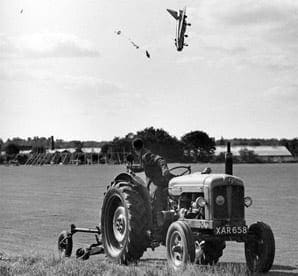 The story behind a famous photograph of an ejection from a Lightning. – The photograph opposite was taken by Jim Meads on 13 September 1962. It was published in newspapers all around the world at the time and, as it was so widely seen, it naturally caught the attention of manufacturer Martin-Baker.
The story behind a famous photograph of an ejection from a Lightning. – The photograph opposite was taken by Jim Meads on 13 September 1962. It was published in newspapers all around the world at the time and, as it was so widely seen, it naturally caught the attention of manufacturer Martin-Baker.
At the time Jim lived next door to de Havilland test pilot Bob Sowray in Hatfield, Hertfordshire, and on this day both of their wives had gone clothes shopping in London. Bob had mentioned that he was due to fly a Lightning that day, and later Jim’s children asked if they could go to watch the flight. Although Jim was a photographer, he wouldn’t usually take his camera on an outing like this. However, on this occasion he decided he would get a picture of his neighbour flying. The camera he took had just two exposures on it.
The spectators found a good vantage point close to the threshold of de Havilland’s Hatfield airfield, and waited for the Lightning to return. As XG332 came in on final approach, at around 200ft high its nose pitched up and the pilot ejected. The Lightning had become uncontrollable after an engine fire had weakened a tailplane actuator.
Jim took one photo soon after the ejection, and as can be seen caught the pilot inverted with his parachute still unopened and the Lightning plummeting earthwards close to him. The tractor driver heard the bang of the ejection seat and is seen after quickly turning around to look at what was going on, no doubt very relieved he wasn’t working further over in the field. Jim’s one remaining picture recorded the subsequent plume of thick black smoke after the jet had crashed.
Fortunately the pilot survived after coming down in a greenhouse full of tomatoes. He suffered multiple breaks of his limbs and cuts from the shower of glass that rained down on him after going through the roof of the greenhouse. However, it hadn’t been Bob Sowray at the controls; he had decided to let fellow test pilot George Aird carry out the flight.
XG332 was one of 20 pre-production Lightnings and first flew on 29 May 1959. It was used throughout its flying life by BAC and de Havilland for Firestreak and Red Top trials, and its crash occurred while it was on latter programme.
With many thanks to Jim Meads for kindly supplying original prints of the images.


